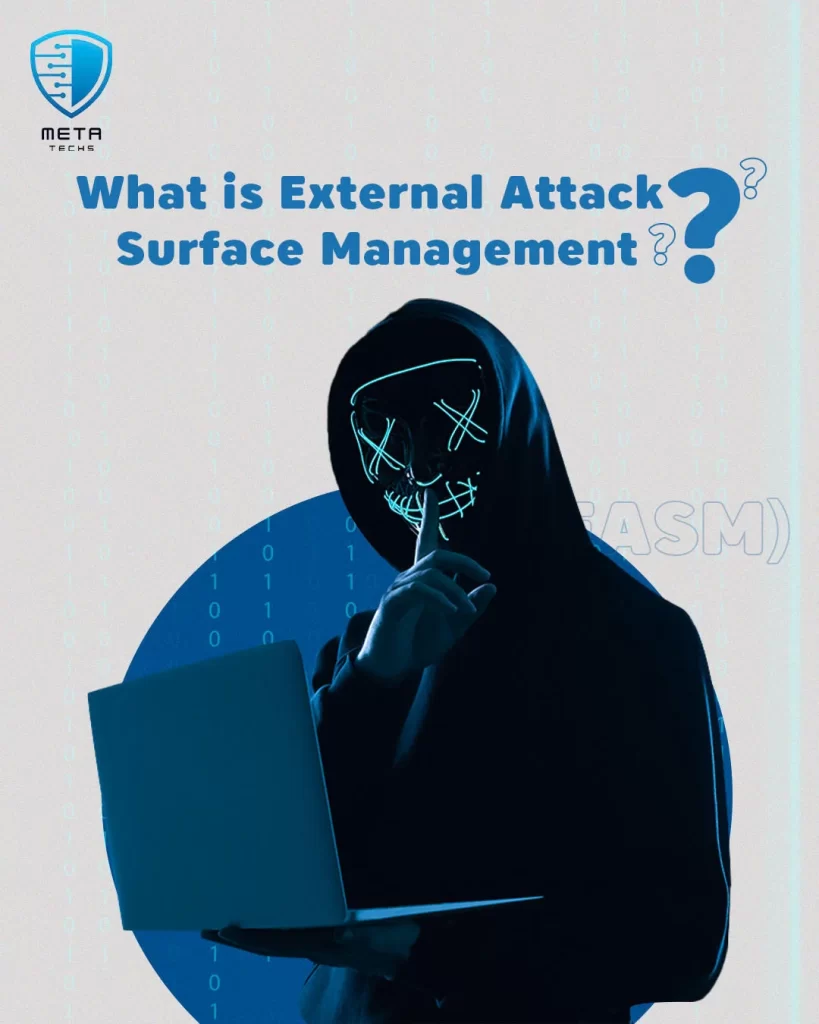One of the more recent realms of strategic defense to emerge is External Attack Surface Management (EASM), which has gained significant attention in the context of modern cyber threats. From the vantage point of an IT professional or a business owner, this article aims to demystify EASM, offering insights into its definition, importance, applications, tools, and how to choose the right EASM solution – all crafted to enhance your grasp of this crucial facet of cyber protection.

What is External Attack Surface Management?
External Attack Surface Management is an evolutionary offshoot of the broader domain of Attack (ASM). ASM, in essence, encompasses every possible means an attacker can use to breach an organization’s information security. The external variation of this concept narrows the focus to those digital entry points which are exposed to the outside world: the internet-facing infrastructure, employee endpoints, cloud assets, social media profiles, and more.
Why is EASM Important ?
External Attack Surface Management provides the crucial visibility needed to understand and mitigate risks from the outside in, making it a foundational layer of any robust cybersecurity strategy. By proactively identifying and addressing vulnerabilities before they can be exploited, organizations can significantly enhance their resilience against cyberattacks. Furthermore, EASM fosters a culture of continuous security improvement, encouraging businesses to stay ahead of potential threats through ongoing monitoring and analysis. In essence, EASM is not just a tool but a strategic approach that enables organizations to stand firm against the evolving landscape of cyber threats, safeguarding their assets, reputation, and ultimately, their future.
The Core Components of an Effective EASM Strategy
An effective External Attack Surface Management strategy rests on several pillars:
Visibility: From subdomains to cloud assets, visibility into every component of the external attack surface is foundational. This visibility must extend to assets you may not even be aware of, such as forgotten web pages or services launched by former employees.
Continuous Monitoring and Assessment: The digital realm is dynamic, with new threats emerging daily. Continuous monitoring for vulnerabilities, exposures, and potential threat activities ensures timely responses to risks.
Integrated Intelligence: Aligning EASM efforts with threat intelligence feeds provides contextual information about emerging threats and exploits, making it possible to prioritize risks and focus on what matters most.
Collaborative Remediation: Bridging the gap between discovery and resolution of vulnerabilities necessitates collaboration across multiple organizational departments. Security, IT, and business units should work together to implement remediations efficiently
Common Uses
EASM services have a diverse range of applications across sectors, adeptly serving both the needs of burgeoning start-ups and sprawling multinational corporations alike. Primarily, these tools are instrumental in identifying unknown assets and vulnerabilities, potentially saving organizations from unforeseen breaches. Beyond mere identification, EASM tools are extensively used to prioritize those vulnerabilities, guiding security teams where their attention is most critically needed. In regulatory compliance, they ensure organizations meet industry standards by maintaining a secure digital environment. Additionally, EASM tools play a pivotal role in merger and acquisition scenarios, providing external security assessments that inform decision-making processes. Whether it’s fortifying defenses, ensuring compliance, or securing transactions, the common thread in all these uses is the drive to protect an organization’s digital presence against the constantly evolving threat landscape.
what are EASM Tools?
EASM Tools, or External Attack Surface Management Tools, are specialized software solutions designed to automate the discovery, analysis, and management of an organization’s external digital footprint. They play a pivotal role in identifying vulnerabilities and exposures across publicly accessible digital assets before they can be exploited by cyber attackers. Here are five notable EASM tools that have garnered attention for their effectiveness:
Qualys: cloud-based platform that offers asset discovery, network security, compliance monitoring, and web application scanning among its diverse functionalities.
Tenable.io: Known for its vulnerability management capabilities, Tenable.io provides extensive visibility into all external assets, enabling organizations to understand and reduce their cyber risk.
Rapid7 InsightVM: Rapid7 InsightVM excels in real-time end-to-end visibility into the attack surface, offering powerful analytics to drive effective vulnerability management and remediation strategies.
Expanse: Expanse specializes in monitoring the internet to identify exposed and potentially at-risk assets linked to an organization, helping to mitigate risks before they lead to security incidents.
BitSight: Offers a unique approach by providing continuous monitoring and grading of companies’ security performance over time, helping organizations to benchmark their security posture against industry standards and competitors.
What is the Difference Between EASM and CAASM?
When discussing cybersecurity strategies, both External Attack Surface Management (EASM) and Cyber Asset Attack Surface Management (CAASM) play crucial roles but serve distinct purposes. The principal difference between EASM and CAASM lies in their scope and focus within an organization’s security posture.
EASM (External Attack Surface Management) focuses primarily on identifying and managing the risks associated with externally facing assets, such as websites, web applications, and cloud services. Its primary goal is to discover, inventory, and secure an organization’s digital footprint on the internet, including unknown, unmanaged, or poorly managed internet-facing assets.
On the other hand, CAASM (Cyber Asset Attack Surface Management) presents a broader approach. It encompasses the management and security not just of external assets but all cyber assets, including internal network devices, IoT devices, cloud instances, and software applications, whether they are visible externally or only internally. The core of CAASM is to provide visibility and management across all of an organization’s assets and their interconnections, thus enabling more effective risk identification and security posture management across the entire cyber ecosystem.
How Does EASM Work?
External Attack Surface Management (EASM) operates through a multi-step process designed to systematically identify, assess, and manage the risks associated with an organization’s external digital footprint. Initially, EASM solutions automate the discovery of an organization’s publicly accessible digital assets, including domains, IPs, web applications, and cloud services. This comprehensive inventory serves as the foundation for subsequent steps.
Following asset discovery, these tools assess each identified asset for vulnerabilities, misconfigurations, and compliance issues using a combination of passive scanning and active probing techniques. By employing such methods, External Attack Surface Management tools can pinpoint potential security weaknesses without impacting the operational integrity of the assets.
The next phase involves prioritization, where identified vulnerabilities are ranked based on severity, exploitability, and their potential impact on the organization. This step ensures that security teams can focus their efforts on remedying the most critical vulnerabilities first, optimizing resource allocation for maximum security benefit.
Finally, External Attack Surface Management tools facilitate ongoing monitoring and alerting for the organization’s digital assets. This continuous vigilance helps in detecting new assets and vulnerabilities as they arise, enabling timely mitigation actions and keeping the organization’s external attack surface as secure as possible. Through these meticulously orchestrated steps, EASM provides organizations with a dynamic and proactive approach to securing their external digital presence against evolving cyber threats.
What are the Benefits of EASM?
Implementing External Attack Surface Management (EASM) offers several compelling benefits that bolster an organization’s cybersecurity defenses. Firstly, EASM provides accurate inventory of all publicly accessible digital assets, ensuring that all external-facing components are accounted for and monitored. This visibility is crucial for understanding the full scope of an organization’s potential exposure to cyber threats.
Secondly, by automating the discovery and assessment of vulnerabilities, External Attack Surface Management tools significantly reduce the time and manpower typically required for these tasks. This efficiency allows security teams to address vulnerabilities more promptly, thereby minimizing the window of opportunity for attackers.
Another key advantage is the ability of EASM to enhance an organization’s cyber resilience. Through continuous monitoring and the proactive identification of security flaws, organizations can anticipate and mitigate potential attacks before they occur. This proactive stance is far more effective than responding to incidents post-breach.
Meta Techs IT Solution Provider | Essential EASM Tools
Meta Techs IT has identified EASM as a pillar of modern cybersecurity strategy. To this end, we offer a suite of EASM tools designed to be versatile and effective in securing your external attack surface. Our solutions cater to a cross-section of industries and have consistently delivered robust risk management and vulnerability identification capabilities.
the formidable cybersecurity challenge is not merely to counteract known threats but to anticipate and pre-empt those yet to emerge. With the right External Attack Surface Management measures in place, organizations can instill confidence in their stakeholders, secure their assets, and maintain operational integrity in the face of an increasingly hostile cyber environment.








